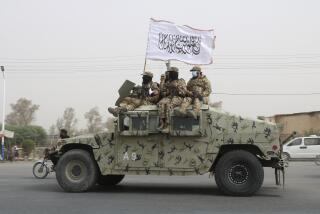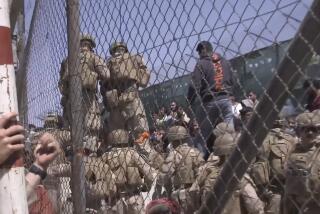U.S. troop deaths in Afghanistan war fell in 2011
- Share via
Reporting from Kabul, Afghanistan —
It was by no means a common occurrence. But in the year that just drew to a close, a day would often pass, sometimes several, without an American service member dying in Afghanistan.
For the first time in years, U.S. military deaths here declined in 2011. American and Taliban commanders have very different explanations, and very different views of what that means for Afghanistan in the new year and beyond.
As they prepare to accelerate their withdrawal from Afghanistan, U.S. officials speak of having turned a corner in 2011. From the Taliban perspective, the Americans took fewer fatalities only because they lost the taste for aggressive combat.
Until last year, U.S. fatalities in the decade-long conflict had usually climbed — sometimes sharply — from year to year, peaking in 2010 at 499. That number dropped last year to 417, according to the independent website icasualties.org — a significant drop, but still averaging more than one per day.
Overall deaths in the NATO force fell even more, from 711 in 2010 to 565 last year.
U.S. officials say successful tactics and the impact of sheer numbers broke the momentum of the Taliban and other armed militant factions in 2011, when American troop strength topped out at more than 100,000. Since summer, 10,000 U.S. troops have left, and an additional 23,000 are scheduled to depart in 2012.
The flexing of that military muscle led to some of the most triumphal rhetoric in years about the Afghanistan war effort. U.S. Defense Secretary Leon E. Panetta, visiting the country in mid-December, told American troops that they were “winning this very tough conflict.”
The commander of Western forces in Afghanistan, U.S. Marine Gen. John Allen, has been more circumspect. The standard language he used during a series of holiday visits that took him to American outposts scattered across the country was echoed in his year-end message to U.S. forces: “Every one of you here is contributing to the liberation of a country and giving Afghanistan hope.”
The upbeat assessment, however, contains a paradox: If an increase in troop strength helped produce a turnaround, will the pullback set the stage for a reversal?
The insurgents insist that is already happening. Taliban spokesman Zabiullah Mujahid attributed the decrease last year in Western military fatalities to a decline in major offensives.
“They have not conducted any huge operations anywhere,” he said. “This year NATO forces have maintained defensive positions. They are not coming out of their bases. They have reduced their mobility everywhere.”
Western commanders say that is untrue, pointing to aggressive campaigns in recent months in eastern Afghanistan, near Pakistan’s tribal areas. Senior U.S. officials expect the military focus in the coming year to be on the east, a stronghold for one of the most dangerous insurgent groups, the Haqqani network.
Even though Allen has reportedly been lobbying the White House to slow down the American pullback, he and other Western commanders assert that diminishing numbers of North Atlantic Treaty Organization troops will not pose difficulties.
Afghan forces are stepping up their role, taking the lead in more and more parts of the country. Western and Afghan officials say they are on track to meet target numbers that will bring Afghan troop strength to 195,000 by October.
Another enduring question is the capability of Afghan forces.
High attrition rates make it hard for recruitment to keep pace with demand. And too-eager recruitment is thought to have been behind incidents in which Afghan troops turn their guns on Western mentors. That happened again Thursday, when an apparent Taliban sympathizer in the ranks of the Afghan army killed two French troops who were members of the Foreign Legion.
Vetting standards were tightened last year to filter out recruits with insurgent sympathies, but officials acknowledge that the task is difficult.
As the year drew to a close, Afghan military leaders also complained that they were not being provided with the sophisticated armaments they would need to take the lead in fighting insurgents by 2014, when the Western combat role is to formally end. Afghan President Hamid Karzai’s office said he had called on the NATO force to equip the police and army with heavy weapons “so they can defend their own soil.”
The Taliban, meanwhile, pointed to their ability to harry a more powerful enemy with a crude but lethal weapon of choice, the roadside bomb, which remained the single biggest killer of U.S. and other Western troops in 2011.
As in the past, troop fatalities tended to come in clusters, caused by single roadside bombings. On Dec. 22, five Polish troops in Ghazni province, south of Kabul, the capital, died in a blast that blew their armored vehicle apart.
Taliban commanders sometimes deliberately target non-U.S. contingents because they know that in many countries, public opposition to the war tracks any sudden rise in the number of battlefield deaths.
Another relatively low-tech weapon, the rocket-propelled grenade, caused the worst single U.S. troop loss of the war. Thirty Americans and eight Afghans were killed in the Aug. 6 crash of a Chinook helicopter carrying mainly elite Navy SEALs.
“In 2011 we fought more strongly than in any year before, and staged more high-profile attacks than in previous years,” said Mujahid, the Taliban spokesman. Chief among those assaults, he said, were September’s 20-hour siege of the U.S. Embassy in Kabul and a similar prolonged attack on the landmark Intercontinental Hotel in the capital three months earlier.
The Taliban’s continuing shift away from conventional battlefield confrontations led to growing numbers of civilian deaths in the first three-quarters of last year, according to the United Nations.
There was some indication such deaths might be turning the Afghan public against the Taliban; an Asia Foundation study released in November found decreasing support among Afghans for the movement’s goals. But concern over civilian casualties cuts both ways.
Throughout the year, Karzai voiced harsh criticism of U.S.-led operations that he said posed undue hazards to Afghan citizens.
The Afghan leader’s demand for an end to American participation in nighttime raids on residential compounds emerged as a potentially serious obstacle to a long-term partnership agreement, which will govern the U.S. military presence after 2014.
As 2012 begins, the Afghan government and the Obama administration are looking for ways to negotiate a settlement with the Taliban.
In late December, Karzai agreed to the opening of a Taliban liaison office in Qatar, though some members of his administration fear U.S. officials will keep them in the dark about their contacts with the insurgents.
Pakistan’s role will be crucial too, but the prospects for help seemed dim because of a sharp deterioration in ties between Washington and the government in Islamabad.
The Taliban leadership ended the year on a taunting note, asserting that the Americans were looking for a way out, just like the Soviet invaders who arrived 32 years ago. “They are on the point of fleeing,” it said in a statement.
U.S. and NATO officials stressed that they were not abandoning the country, but preparing for an orderly transfer.
“At the end of 2011, we have three years to go, and that is more than enough to finish the job,” said German Brig. Gen. Carsten Jacobson, a spokesman for the NATO force. “We are not leaving because we have to. We are leaving because we can.”
More to Read
Sign up for Essential California
The most important California stories and recommendations in your inbox every morning.
You may occasionally receive promotional content from the Los Angeles Times.










